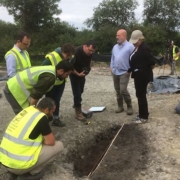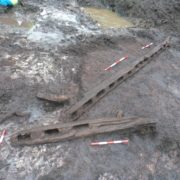Palaeo-environmental Coring
As part of the archaeological investigations for the N69 road project, palaeoenvironmental specialists Carlos Chique and Karen Molloy from NUI Galway took a pollen core from Derra West Bog close to the location of bypass.
The team use pollen trapped in the layers of peat to create a picture of the changing environment through time. The core taken from Derra West Bog spans most of the Holocene (the last c. 12,000 years of Earth’s history) and comprises a very comprehensive record of human activity spanning from the Neolithic (c. 4000 BC) to relatively modern times (c. AD 1600).
Analysis of the core is currently underway in NUI Galway. The results will provide important insights into how human activity, particularly farming, has altered and shaped the natural environment of the Listowel area since prehistoric times.

 AMS
AMS
 AMS
AMS AMS
AMS AMS
AMS AMS
AMS

 AMS
AMS AMS
AMS